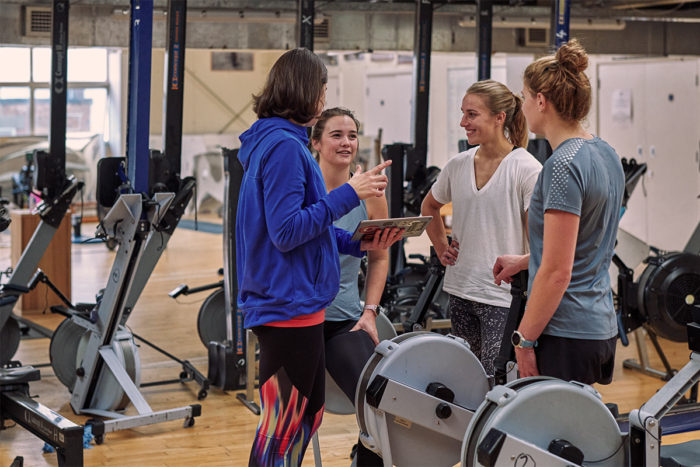Like anything else, it pays to keep it simple
Strength training, for women, is vastly under-emphasised through life. And that’s a shame as it’s a key way to keep the body primed, fit, healthy and durable over time. Let’s meet strength training, what it is and what to know:
What is strength training?
It’s lifting something that’s a challenge. Lifting something challenging prompts the body to react and ‘get stronger’. For some, this means bodyweight squats and for others it might be deadlifting. Regardless of how you do it, you progress only by doing more reps and/ or heavier lifts over time as the body needs to be challenged more if it’s to adapt more.
Why is it important for females to lift weights?
Because strong bodies are more resilient when doing exercise and playing sports. Strong bodies can do more. Plus, as women age we start to lose our muscle mass and bone density — from our mid-30s on — and without physical strength, activity stops feeling good. As age creeps up women are also more susceptible to osteoporosis … so strength training can help us swerve this too.
What is the best way to build muscle?
The best way is to overload your system, slightly and progressively. This is GCSE physics: for every action there’s a reaction, and the bigger the action, the bigger the reaction. But more isn’t necessarily better – overshooting can cause strain and harm. We only need to lift enough for the body to react, and we have to keep the mindset that we can always lift a bit more.
What types of exercise should I do?
Ones that involve big muscle groups. We recommend focussing on the basics when it comes to strength training: squats, deadlifts, leg press, bench press, chin-ups. It’s better to add load to these lifts before adding in functional variations that target multiple muscle groups at once. These variations are helpful but they can also distract from the main purpose of strength training … which is increasing strength.
Where should I start with strength training?
Strength training for women, funnily enough, starts with honesty. Begin by being honest with yourself as to where you’re at right now. If you’ve never lifted — or haven’t done for ages — then we’d suggest going to a gym and asking a trainer for some tips, or to write you a starter programme. Once you’re confident in the basics, the theory is simple: focus on establishing great technique and add load / challenge yourself from there.
How do I know how much weight to lift?
If you’re bashing through the session at 50% effort then it’s too easy – so add more load. The final couple of reps should be a struggle but within that struggle you should be able to maintain your technique and a good range of movement. If you have to change or compromise on your movement or technique then you’re lifting too heavy.
What if I don’t have any equipment?
First, consider joining a gym. If that’s not possible, and you don’t otherwise have access to equipment then be creative: add impact (jumping / skipping) to your workout to increase load. It’s not the same as lifting – but it’s a solid compromise.

Will strength training help me lose weight?
Absolutely it can as it builds muscle mass and reduces fat mass. Note that you won’t bulk up unless you’re specifically trying to, but that doesn’t mean you’re not getting stronger.
Can strength training reverse the ageing process?
Reverse it, no. But it can certainly reduce the rate at which you lose muscle and bone density, which are natural parts of the ageing process. See our article on how to exercise in menopause for more.
Will strength training improve my running?
In a way, yes. A stronger body is less likely to get injured and tends to recover from exercise (running, for example) more quickly. We also find that a stronger body enjoys better quality run days. It can be a psychological challenge for runners to replace run days with strength days but the combination often produces better results in performance, body composition and even enjoyment.
Why is strength training important for female athletes?
Strength training is something many of us were never taught to do, or at least how to do properly, and there is so much to gain from it. A strong body is more resilient, less likely to suffer pain and injury, and more responsive to the challenges we set ourselves.
Is strength training good for women’s health?
Yes. Not when it’s done to an extreme — too many unhealthy trends, fads and diets accompany strength training nowadays — but strong women tend to have healthy pelvic floors, fewer back problems and better posture. They tend to enjoy training and competition more, too.
How many times a week should I strength train?
Aim for three times a week, ideally with one day’s rest between each. Sessions don’t have to be longer than 30-45 minutes, but three times per week is key to see optimal gains.
TWHQ offer four groundbreaking, evidence-based courses on the female body across her different lifestages.
If you have any feedback, complaints or comments please email us at hello@thewell-hq.com
As a reminder, the content of the course belongs to The Well HQ. You have permission to access and use the content yourself or, if you are an organisation, for the number of users selected, but are not otherwise permitted to share such content with others, all in accordance with our Course Terms and Conditions.
Comments are closed here.